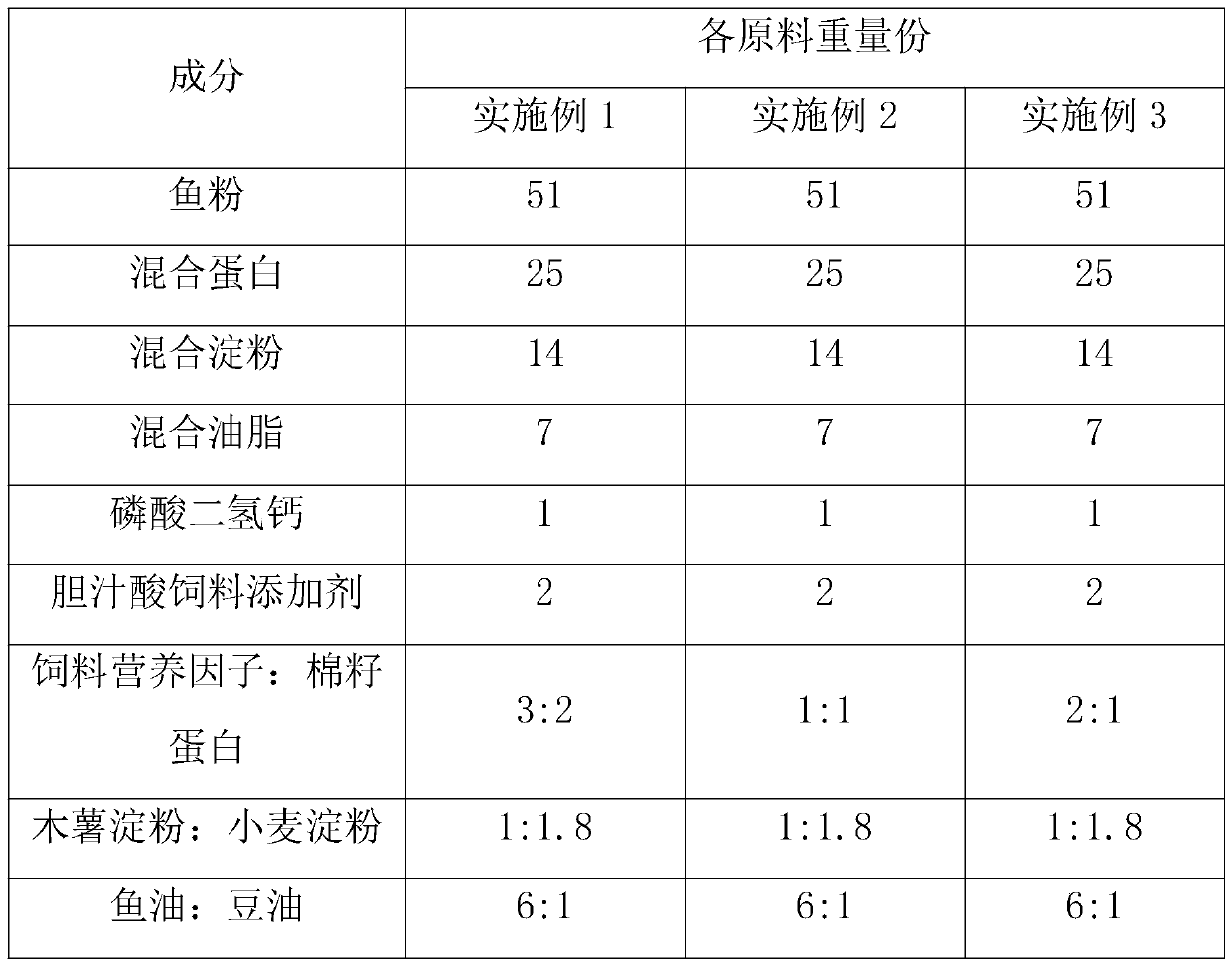Compounded feed for Micropterus salmoides and preparation method therefor
A technology for compound feed and sea bass, applied in the field of California sea bass compound feed and its preparation, can solve the problems of low floating water rate, excessive powder, broken powder, etc., achieve moderate starch content, meet nutritional needs, and promote rapid growth.
- Summary
- Abstract
- Description
- Claims
- Application Information
AI Technical Summary
Problems solved by technology
Method used
Image
Examples
preparation example Construction
[0057] The specific steps of the preparation method of the California perch compound feed of described embodiment 1-3 are as follows:
[0058] 1) First, weigh the feed nutrition factor and tapioca starch according to the weight of the raw materials, mix them evenly, and process them through ultrafine grinding to 500 mesh to obtain the first mixture. The temperature during the ultrafine grinding process is 10° C.;
[0059] 2) Then weigh fish meal, cottonseed protein, wheat starch, calcium dihydrogen phosphate and bile acid feed additives according to the weight of the raw materials, mix them evenly, and grind them to 100 mesh to obtain the second mixture;
[0060] 3) After the first mixture and the second mixture are mixed evenly, they are sent to an extrusion granulator for granulation. During the extrusion granulation, the temperature is 100°C and the humidity is 50%. The pelleted feed obtained is dried at a temperature of 80-90°C;
[0061] 4) After the temperature of the gr...
Embodiment 1
[0070] In this test, the feed prepared in Examples 1-3 and the feed prepared in Comparative Example 3 are soaked and observed. Each test group takes 10 g of feed respectively, puts it into a glass container and soaks it in water for 30 minutes, and observes and records the shape and ups and downs of the feed. The specific results are as follows in Table 2:
[0071]
[0072] From the results in Table 2, it can be seen that the California perch compound feed prepared in Examples 1-3 is stable in shape, and is not prone to crushing and bottom sinking.
[0073] Relative to the feed prepared in Examples 1-3, the feed prepared in Comparative Example 3 appears pulverized and partly sinks to the bottom, indicating that the feed nutritional factor and tapioca starch of the present invention are processed to a specific particle size through ultrafine pulverization, and then mixed with fish meal, Cottonseed protein and wheat starch are prepared in a specific ratio, and the feed is not...
Embodiment 2
[0075] In this experiment, the feed prepared in Examples 1-3 and the feed prepared in Comparative Examples 1-3 were used to feed California sea bass cultured in a farm. During the experiment, the same feeding conditions were adopted except for the different feed components, and 270 California perch were cultured in each test group, and the experiment lasted for 90 days. Before the test, the initial body weight of the California perch was recorded, and the number and final body weight of the California perch were recorded after the test, and the survival rate and average weight gain rate of the California perch were counted. Wherein, the determination of body weight data is the result obtained by randomly picking 50 California perch in each cage and taking the average value. Table 3 is the result of survival rate; Table 4 is the result of average weight gain rate.
[0076] table 3
[0077] Feed test group mantissa before test mantissa at the end of the test Sur...
PUM
 Login to View More
Login to View More Abstract
Description
Claims
Application Information
 Login to View More
Login to View More - R&D
- Intellectual Property
- Life Sciences
- Materials
- Tech Scout
- Unparalleled Data Quality
- Higher Quality Content
- 60% Fewer Hallucinations
Browse by: Latest US Patents, China's latest patents, Technical Efficacy Thesaurus, Application Domain, Technology Topic, Popular Technical Reports.
© 2025 PatSnap. All rights reserved.Legal|Privacy policy|Modern Slavery Act Transparency Statement|Sitemap|About US| Contact US: help@patsnap.com


